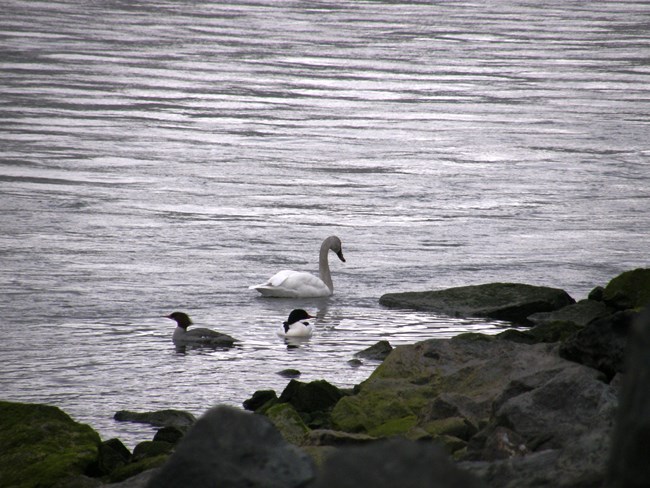Last updated: September 13, 2021
Article
Redwood Creek Winter Birding
The Mouth of Redwood Creek Is A Hotspot for Cold Weather Birds
This spring (2018), at Redwood National and State Parks, local bird watchers - commonly called “birders” - have been a twitter over several unusual or rare birds sighted at or near the Redwood Creek estuary. The first was a very rare bird for California, a female Steller’s Eider (duck) seen on March 7th, 2018 by Jeff Allen (who found the Common Pochard in 2016 at Freshwater Lagoon) offshore near the mouth of Redwood Creek. The bird was sighted again on March 10th , 2018 by a few birders, and seen once more on March 14th by a single birder. If confirmed, it would only be the 4th record of this species for all of California.An Iceland Gull was spotted at the mouth of Redwood Creek on the March 11 in a large mixed flock of gulls. This species is separated into 3 subspecies, with the Thayer’s Gull being the one most commonly seen here. This individual was of the “Kumlien's" form, found generally along the east coast of the United States and nesting in northeastern Canada.
An immature Tundra Swan was spotted on the March 12th by Redwood National and State Parks (RNSP) biological science technician, Heather Brown. The swan was feeding along the edge of the south levee of Redwood Creek. Normally these birds can be found at the Humboldt Bay Wildlife Refuge in winter. Seeing one in fast moving water is unusual, and it is only the 8th record of this species within RNSP lands.

NPS: Heather Brown
Black-legged Kittiwakes winter out to sea “along the outer ocean shelves and deep water habitats” (USFWS) of the west and east coasts of the United States. They nest in limited areas of Alaska, especially along the Aleutian Islands as well as along a limited area of eastern coastal Canada. Black-legged Kittiwakes, according to Stan Harris’s book, are called an uncommon migrant, with peak numbers showing up in early spring, and “almost never seen shoreward of the immediate surf”.
All in all, a stellar few days for our local birding community here in Redwood National and State Parks.
Prepared by Heather Brown, Biological Science Technician for Redwood National and State Parks.
References:
Harris, Stanley W. 2005. Northwestern California Birds. Living Gold Press
www.allaboutbirds.org, The Cornell Lab of Ornithology
www.audubon.org, The National Audubon Society
www.fws.gov/alaska US Fish and Wildlife Service: Alaska
